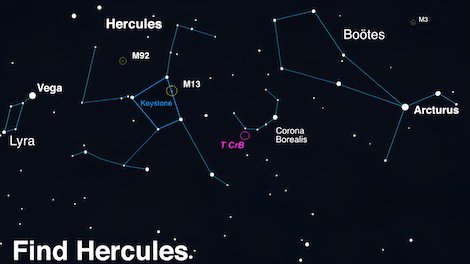A Star System’s Outburst From 3,000 Light-Years Away will Be Visible From Cleveland
by Annie Nickoloff | Oct. 1, 2024 | 3:05 PM

Courtesy NASA/CXC/M.Weiss, Courtesy Stellarium
Any day now, the Blaze Star, aka T Coronae Borealis, is expected to create an explosion that comes around like clockwork — and that astronomers all around the world are watching with anticipation.
We caught up with Nick Anderson, the senior astronomer with the Cleveland Museum of Natural History, to hear more about the celestial event.
So, what’s happening?
A nova — basically, two stars orbiting one another. Specifically, a large red giant star, nearing the end of its life, adjacent to a dense white dwarf. “With these binary systems, the white dwarf can actually rip material, like, steal matter, away from its companion star,” Anderson says. “This material, which is mostly hydrogen, starts to pile on to this white dwarf, building up this atmosphere — and as this happens, the pressure and temperature start to skyrocket, ultimately leading to this thermonuclear explosion.”
That explosion will be visible to the naked eye.
Don’t get it mixed up with a supernova (a cataclysmic explosion at the end of a massive star’s life). A nova is still an impressive burst, but not as huge, Anderson says.
RELATED: Once-In-a-Lifetime: Total Solar Eclipse Puts a Spotlight on Cleveland
Has it happened before?
For the Blaze Star, a recurrent nova happens about every 80 years. The last time it was observed was in 1946.
There are about 10 other recurrent novae known by astronomers, Anderson says.
When is it going to happen?
Soon — but how soon is anyone’s guess. Some estimates predicted it would take place in September.
“It could be tonight, could be next week, might not happen until winter,” Anderson says. “It’s tough to say.”
Where can I see it in the night sky?
First, you’ll want to get away from city light, and hopefully on a cloudless night. (At Cleveland Magazine, we recommend Montville’s Observatory Park, which we featured last year.)
Find it in the Northern Crown — the Corona Borealis. It’s one of Anderson’s favorite constellations. In October, you’ll see it over the western sky after sunset. Use a finder chart, sky maps or a constellation app to pinpoint the exact location. “Just to find Corona Borealis, that little semi-circle of stars, it’s positioned midway between two really bright, brilliant stars in the evening sky, now named Arcturus and Vega,” Anderson says. “You can kind of use those as a guide, and halfway between those two stars is roughly the patch of sky you’d want to be looking at.”
In the image below, look for T CrB (T Coronae Borealis):

(Photo courtesy Stellarium; Lead photo courtesy NASA/CXC/M.Weiss)
For more updates about Cleveland, sign up for our Cleveland Magazine Daily newsletter, delivered to your inbox six times a week.
Cleveland Magazine is also available in print, publishing 12 times a year with immersive features, helpful guides and beautiful photography and design.

Annie Nickoloff
Annie Nickoloff is the senior editor of Cleveland Magazine. She has written for a variety of publications, including The Plain Dealer, Alternative Press Magazine, Belt Magazine, USA Today and Paste Magazine. She hosts a weekly indie radio show called Sunny Day on WRUW FM 91.1 Cleveland and enjoys frequenting Cleveland's music venues, hiking trails and pinball arcades.
Trending
-
1
-
2
-
3
-
4
-
5










